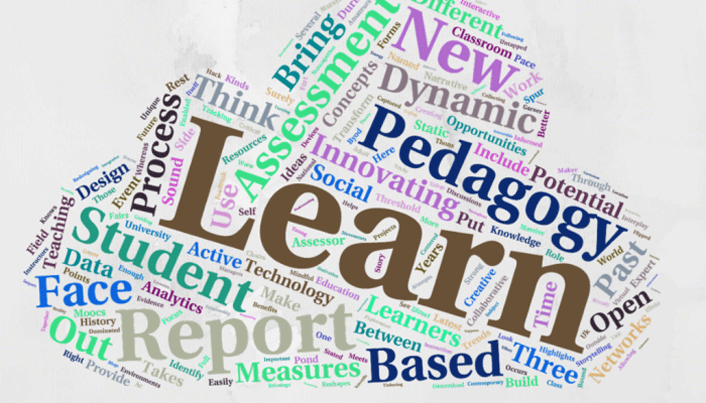
For the past three years, the U.K.-based Open University has put out an Innovating Pedagogy report. These reports identify “new forms of teaching, learning, and assessment for an interactive world.”
Several of the 10 innovations named in the latest report will sound familiar to people tracking learning technology trends in the U.S. But the rest are surely unique enough to spur new thinking on this side of the pond.
Here are the highlights:
 Massive open social learning – This pedagogy brings the benefits of social networks to MOOCs by creating opportunities for learning-based discussions and collaborative projects.
Massive open social learning – This pedagogy brings the benefits of social networks to MOOCs by creating opportunities for learning-based discussions and collaborative projects.
 Learning design informed by analytics – As the analytics field matures, there is untapped potential for the interplay between collecting the right kinds of data—including those data points that are not easily captured—and using it as evidence when designing and redesigning learning activities.
Learning design informed by analytics – As the analytics field matures, there is untapped potential for the interplay between collecting the right kinds of data—including those data points that are not easily captured—and using it as evidence when designing and redesigning learning activities.
 Flipped classroom – This pedagogy attempts to make better use of learning environments. Direct instruction occurs outside the classroom, allowing students to work at their own pace. The face-to-face class time has the potential to then transform to more active and collaborative learning, critical-thinking, and creative exploration.
Flipped classroom – This pedagogy attempts to make better use of learning environments. Direct instruction occurs outside the classroom, allowing students to work at their own pace. The face-to-face class time has the potential to then transform to more active and collaborative learning, critical-thinking, and creative exploration.
 Bring your own devices – BYOD reshapes the role of instructors as “managers of technology-enabled networked learners, rather than providers of resources and knowledge.”
Bring your own devices – BYOD reshapes the role of instructors as “managers of technology-enabled networked learners, rather than providers of resources and knowledge.”
 Learning to learn – This report takes a contemporary look at metacognition through mindful learning and self-determined learners.
Learning to learn – This report takes a contemporary look at metacognition through mindful learning and self-determined learners.
 Dynamic assessment – Rather than measuring what a student already knows and can do, dynamic assessment measures a student’s potential to learn. Three differences stated in the report between dynamic assessment and static assessment include the following:
Dynamic assessment – Rather than measuring what a student already knows and can do, dynamic assessment measures a student’s potential to learn. Three differences stated in the report between dynamic assessment and static assessment include the following:
- The focus of dynamic assessment is on guiding future development, whereas static assessment measures past achievement
- The assessor and student relationship is different, since the assessor intervenes during the process
- With dynamic assessment there is feedback to the student during the assessment process
 Event-based learning – Think maker fairs and hack-a-thons. Time-bound face-to-face learning events bring amateurs and experts together in one location, and the national and international movements surrounding them provide motivation and energy that garner new resources and opportunities for knowledge-building.
Event-based learning – Think maker fairs and hack-a-thons. Time-bound face-to-face learning events bring amateurs and experts together in one location, and the national and international movements surrounding them provide motivation and energy that garner new resources and opportunities for knowledge-building.
 Learning through storytelling – The scientific process has dominated learning pedagogy in recent history, but storytelling has a strong tradition for learning throughout human history. As a pedagogy, narrative is important for meaning-making and helps learners build coherence among different ideas. Narrative-centered learning immerses learners in a story, like game-based learning and virtual reality.
Learning through storytelling – The scientific process has dominated learning pedagogy in recent history, but storytelling has a strong tradition for learning throughout human history. As a pedagogy, narrative is important for meaning-making and helps learners build coherence among different ideas. Narrative-centered learning immerses learners in a story, like game-based learning and virtual reality.
 Threshold concepts – These concepts are tricky and troublesome to learn, but when learned, they are transformative, irreversible, and integrative. Understanding threshold concepts and how they impact learning in a subject area elicits new ideas about curriculum and teaching.
Threshold concepts – These concepts are tricky and troublesome to learn, but when learned, they are transformative, irreversible, and integrative. Understanding threshold concepts and how they impact learning in a subject area elicits new ideas about curriculum and teaching.
 Bricolage – Improvisation meets tinkering. Creative adult education takes lessons from young children who are expert at manipulating materials to a deliberate effect, like turning sheets and chairs into a hideaway fort. It’s also a process that supports innovation in education itself: “trying things out to see how they work.”
Bricolage – Improvisation meets tinkering. Creative adult education takes lessons from young children who are expert at manipulating materials to a deliberate effect, like turning sheets and chairs into a hideaway fort. It’s also a process that supports innovation in education itself: “trying things out to see how they work.”
